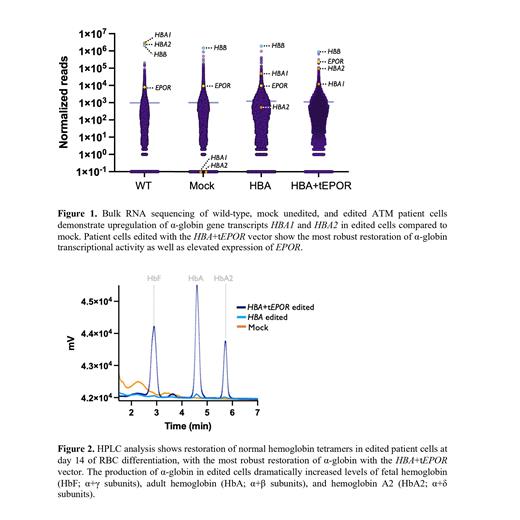Introduction: α-thalassemia major (ATM) is an autosomal recessive disorder where all four copies of the α-globin gene are deleted. A traditionally lethal disease due to severe fetal hypoxia, this condition is now survivable due to the advent of in utero blood transfusions. However, patients still require life-long transfusions postnatally. While allogeneic hematopoietic stem cell transplant (HSCT) can provide a definitive cure, it is limited by the paucity of suitable donors, has a high morbidity and mortality due the prerequisite myeloablative regimens, and carries the risk of immune rejection and graft-versus-host disease. Here, we describe a CRISPR/AAV-mediated genome editing strategy to restore a full-length copy of the α-globin gene at the β-globin locus in ATM patient-derived HSCs to restore normal hemoglobin production to a patient's red blood cells (RBCs).
Methods: We identified a Cas9 gRNA that efficiently introduced indels at the HBB locus as well as an AAV6 vector that mediated efficient integration into the start codon of HBB. After designing and testing integration cassettes, we developed two candidate vectors that insert a HBA1 transgene at the HBB locus, with one bicistronic vector that also expresses a truncated form of the erythropoietin receptor (t EPOR) to increase erythropoietic output from edited HSCs. We used this approach to edit CD34 + HSCs derived from the bone marrow of three patients with ATM. Edited cells were cultured for 16 days in RBC differentiation media. Editing rates were quantified by a custom ddPCR assay. To determine the transcriptional response to these editing strategies, bulk RNA sequencing was performed comparing wild-type cells and patient cells that underwent respective editing conditions. Lastly, α-globin protein production was quantified using tetramer and single-globin high protein liquid chromatography (HPLC).
Results: While effective editing frequencies in ATM HSCs were achieved by the HBA integration vector (39% edited alleles), we observed that editing rates increased over the course of RBC differentiation in the combined HBA+t EPOR edited condition, reaching 76% edited alleles by day 16. We also found that total cell counts by the end of RBC differentiation more than doubled (2.2-fold) in the HBA+t EPOR condition compared to the HBA alone condition. RNA sequencing of edited ATM-derived HSCs following RBC differentiation revealed an upregulation of HBA1, HBA2, and EPOR transcripts compared to unedited patient cells. These results were supported by HPLC, which demonstrated restoration of hemoglobin tetramers, including fetal hemoglobin (α+γ subunits), adult hemoglobin (α+β subunits), and hemoglobin A2 (α+δ subunits) compared to unedited patient cells. Complementing this with globin single chain analysis found that we had achieved 11% restoration of α-globin compared to wild-type levels. In spite of integration at the HBB locus, neither RNA sequencing nor HPLC showed disruption of β-globin production. α-globin production with a concomitant decrease in the formation of toxic β-globin dimers was confirmed by Western blot, with restoration of the normal balance of α-globin to dimeric β-globin in edited cells to wild-type levels.
Conclusions: To our knowledge, these results demonstrate for the first time that gene therapy or genome editing may be used to increase α-globin production in ATM patient-derived RBCs. We found that the editing strategy that paired site-specific α-globin integration with t EPOR expression achieved the highest editing frequencies, greatest production of edited cells, and the most robust production of α-globin protein compared to α-globin integration alone. By increasing erythropoietic output using t EPOR, this approach has the potential to overcome some of the clinical challenges previously seen in HSCT for the hemoglobinopathies, including low editing and engraftment rates. Moreover, as patients with severe anemia such those with ATM have increased levels of circulating erythropoietin due to severe anemia, a t EPOR-based enrichment strategy is likely to be especially potent following transplantation into ATM bone marrow. We believe this could allow clinicians to reduce or eliminate the need for myeloablation, which stand as a major barrier to HSCT safety and efficacy. These findings support development of a definitive ex vivo autologous genome editing strategy that may be curative for ATM.
Disclosures
Porteus:Graphite Biologics: Current equity holder in publicly-traded company, Membership on an entity's Board of Directors or advisory committees; Allogene Therapeutics: Current equity holder in publicly-traded company, Membership on an entity's Board of Directors or advisory committees; Alaunos Therapeutics: Current equity holder in publicly-traded company, Membership on an entity's Board of Directors or advisory committees; Kamau Therapeutics: Current equity holder in private company; CRISPR Tx: Current equity holder in publicly-traded company.


This feature is available to Subscribers Only
Sign In or Create an Account Close Modal